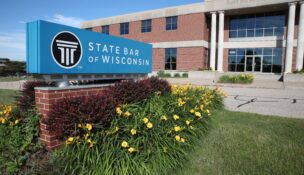LEGAL CENTS: Why your firm should consider Pinterest for marketing
By: Jane Pribek//March 18, 2013//
LEGAL CENTS: Why your firm should consider Pinterest for marketing
By: Jane Pribek//March 18, 2013//

When Pinterest comes up in conversation, typically it’s within the context of women talking about crafting or recipes.
That’s how I first heard about it, and being more like Peg Bundy than June Cleaver, I didn’t rush to sign up.
But it turns out that Pinterest, a social media platform that works like a virtual bulletin board, is a rapidly growing sales and advertising goldmine. After just three years in existence, it has acquired about 48 million users, including Michelle Obama.
Now law firms are looking to tap into that client-rich marketplace.
Megan Eatough, marketing director for Gerbers Law in Green Bay, said her firm recently decided to try Pinterest as a legal marketing tool.
About three-quarters of Pinterest users are women, but Eatough said men are using the service more every day, as are businesses. In fact, starting last year, you can join Pinterest as a business, and Pinterest even posts case studies of companies that have effectively used it for marketing.
“People are finding out, more and more, that Pinterest isn’t just recipes and clothing anymore,” legal marketing expert Christopher Dreyer said. “There’s still an abundance of that, but there are many other businesses that have incorporated Pinterest, from sporting events to do-it-yourself projects.
“It’s definitely the social medium for shared images and video.”
And even if Pinterest remains mostly a female phenomenon, Eatough said, that’s a strong customer base.
“A lot of women make the purchasing decisions for the home,” she said, “They’re a good group to market to.”
Businesses can create a profile in about two minutes by uploading a logo, linking to a website and posting text describing the firm.
Users create “boards,” or categories of images, and “pin” images or video to those boards. You find images either by searching other Pinterest users’ boards to re-pin, or you can pin images from the Internet or upload your own images.
Users who follow you or your business can see the things you pin, re-pin them for their own use and share them with others. They also can post comments.
So far, Eatough said she has created eight boards. For “Areas of Practice,” she borrowed images and text directly from the firm’s website. She also created boards for the firm’s blog, hot topics in law, legal news, legal marketing and social media. There’s even a board with local focus: “Green Bay and Northeast Wisconsin News.”
Eatough next plans to pin items to the firm’s attorney and staff bio board; she’s just waiting for new photos. It’s important to have high-quality, fresh images, she said, and the more unique, the better.
“You need to have compelling images to get people to pay attention to your content,” she said.
Dreyer, of Attorney Rankings in Marion, Ill., recommended creating a board for every practice area, using key words. Don’t just randomly pin, he warned, and don’t create too many boards. Four boards per row are visible from a desktop or laptop. From mobile devices, typically just the top four rows, or 16 boards, can be viewed.
Make at least one “fun” board, Dreyer said, such as one that shows photos of lawyers and staff members engaging in community events, enjoying hobbies or other things that show the lighter side of your employees.
To draw users from your firm’s website and/or blog, Eatough recommends adding a “pin it” button to those online spaces, making it easier for people to re-pin, and thereby share, your content.
To further encourage interactions that will draw the attention of potential clients, Dreyer said to occasionally update images to encourage re-pining. Be sure to thank someone who likes a pin, he said, and follow that user back.
“[Pinterest is] another way to cultivate relationships and retain customer loyalty,” he said.
Although it’s too soon to tell, Eatough said she hopes Pinterest will drive traffic to the firm’s website and boost its Google page rank.
One legal note, however: Be sure you own and potentially hold the copyrights to images you pin, or get permission of the copyright holder. Images with Creative Commons licenses also can be pinned without permission, just look for the encircled, lower-case “cc.” And, when you see the Pinterest logo by an image, someone’s inviting you to pin it, so you’re probably safe there, too. Finally, give attribution to others’ work.
Legal News
- State Bar leaders remain deeply divided over special purpose trust
- Former Wisconsin college chancellor fired over porn career is fighting to keep his faculty post
- Pecker says he pledged to be Trump campaign’s ‘eyes and ears’ during 2016 race
- A conservative quest to limit diversity programs gains momentum in states
- Wisconsin prison inmate pleads not guilty to killing cellmate
- Waukesha man sentenced to 30 years for Sex Trafficking
- 12-year-old shot in Milwaukee Wednesday with ‘serious injuries’
- Milwaukee man convicted of laundering proceeds of business email compromise fraud schemes
- Giuliani, Meadows among 18 indicted in Arizona fake electors case
- Some State Bar diversity participants walk away from program
- Wisconsin court issues arrest warrant ‘in error’ for Minocqua Brewing owner
- Iranian nationals charged cyber campaign targeting U.S. Companies
WLJ People
- Power 30 Personal Injury Attorneys – Russell Nicolet
- Power 30 Personal Injury Attorneys – Benjamin Nicolet
- Power 30 Personal Injury Attorneys – Dustin T. Woehl
- Power 30 Personal Injury Attorneys – Katherine Metzger
- Power 30 Personal Injury Attorneys – Joseph Ryan
- Power 30 Personal Injury Attorneys – James M. Ryan
- Power 30 Personal Injury Attorneys – Dana Wachs
- Power 30 Personal Injury Attorneys – Mark L. Thomsen
- Power 30 Personal Injury Attorneys – Matthew Lein
- Power 30 Personal Injury Attorneys – Jeffrey A. Pitman
- Power 30 Personal Injury Attorneys – William Pemberton
- Power 30 Personal Injury Attorneys – Howard S. Sicula











